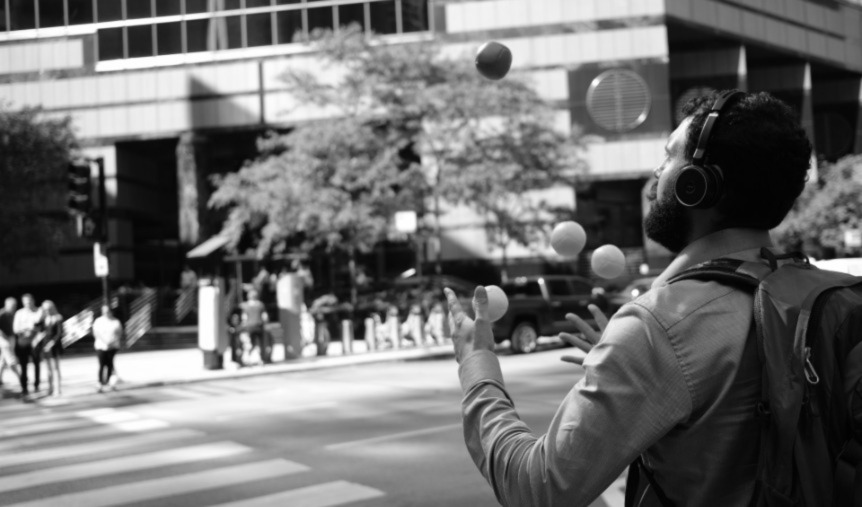Georgetown University professor Cal Newport calls “the ability to focus without distraction on a cognitively demanding task” deep work (Newport, 2016). Deep work is difficult. Indeed, Newport writes:
“We now know from decades of research in both psychology and neuroscience that the state of mental strain that accompanies deep work is also necessary to improve your abilities” (Newport, 2016).
Why should knowledge workers subject ourselves to this effort? Precisely because this thinking is so difficult. Deep work is “hard to replicate”, is “becoming increasingly rare” and is thus “one of the most valuable skills in our economy” (Newport, 2016). Deep work allows us to produce better results in less time and is thus central to productivity.
Deep work and multitasking
We can multitask. We can walk and talk, listen to a podcast while cooking, and sing while doing laundry. But when it comes to cognitive tasks, scientific studies show we can’t direct our attention to two different things at the same time very well.
“Performing two or more tasks at the same time typically results in severe performance costs in terms of increased response latencies and/or error rates” (Fischer & Plessow, 2015).
In other words, multitasking makes us slower and causes us to make mistakes. Cal Newport thus came to the conclusion that in order to push our “cognitive capabilities to their limit”, that is, perform deep work, we need to be in “a state of distraction-free concentration” (Newport, 2016).
Multitasking with cognitively demanding tasks
But why can’t we multitask when it comes to cognitively demanding tasks? The cause is a phenomenon called attention residue. University of Washington associate professor Sophie Leroy conducted research showing that when we context switch, that is, switch from one task to another, some of our attention remains focused on the initial task (Leroy, 2009). That’s why it’s not a great idea to check emails during deep work. Even if we spend only a minute on this activity, it’s not so much the lost time that’s the issue but that we’ve sacrificed precious attention in the time that follows. Multitasking divides and thus compromises our attention. And since deep work pushes us to our cognitive limits, we need all our focus.
Leroy has also conducted research with colleague Theresa Glomb into managing attention residue caused by interruptions (Leroy & Glomb, 2018, 2020). They asked one group of participants to complete a “ready-to-resume” plan before transitioning to their next task. This group did not suffer from attention residue as they worked on the interrupting task and more readily returned to their original work compared with the participants who did not receive the planning advice. The authors propose that having a plan puts our brain at ease because it knows we will return to the task and is clear how to pick back up again. Psychologist Bluma Zeigarnik discovered a related phenomenon that plays a role in hijacking our attention, dubbed the Zeigarnik effect (Cherry, 2021). It turns out that we are able to remember unfinished tasks 90% more often than finished tasks.
How long should we ‘deep work’ for?
There is no scientific consensus regarding how long we can concentrate and evidence of substantial differences between individuals. In some now famous research from the 1990s, Anders Ericsson and colleagues studied the training sessions of elite performers. Their practice sessions were surprisingly short, typically between 45 and 90 minutes, though repeated a few times a day (Ericsson et al., 1993).
A more recent study carried out by the Draugiem Group used an app to track how much time employees spent on particular tasks, and their productivity (Bradberry, 2016). This research showed that how people structured their day was more important than the number of hours worked. Employees who took short breaks were far more productive than those who worked longer hours. The magic ratio was 52 minutes of work followed by 17 minutes of rest. Notably, during the 52 minutes, the highly productive staff did not use social media or get distracted by emails; they were 100% focused on the task. When they got tired, approximately every hour, they detached from their work completely to refresh.
Actionable, evidence-based recommendations
The implications of the research are that you should:
- Complete one task at a time (monotask) when undertaking deep work.
- Deep work for as long as possible (up to around 90 minutes), within the limits of your energy and alertness, to minimize the impact of attention residue throughout the day.
- Take regular breaks to recharge.
- Experiment to find the deep work and rest durations that are optimal for you.
- Finish what you’ve started before moving on to other tasks wherever you can.
- Use “ready-to-resume” plans to manage interruptions and when you have to move on before completing an activity.
- Expect to find deep work difficult initially but easier over time.
More articles on productivity:
- Personal Productivity Tools You’re (Probably) Not Using
- Using Flow, Procrastination and Mind-wandering to Improve Creativity
- How Long Does It Take to Form a New Habit?
References:
- Bradberry, T. (2016). Here’s how much work your brain can handle before needing a break. Business Insider. Retrieved from https://www.businessinsider.com/this-is-the-perfect-amount-of-time-to-work-each-day-2016-1
- Cherry, K. (2021). An Overview of the Zeigarnik Effect and Memory. Verywell Mind. Retrieved from https://www.verywellmind.com/zeigarnik-effect-memory-overview-4175150
- Ericsson, K. A., Krampe, R. T., & Tesch-Römer, C. (1993). The role of deliberate practice in the acquisition of expert performance. Psychological Review, 100(3), 363-406. https://doi.org/10.1037/0033-295X.100.3.363
- Fischer, R., & Plessow, F. (2015). Efficient multitasking: parallel versus serial processing of multiple tasks. Frontiers in Psychology, 6, 1366-1366. https://doi.org/10.3389/fpsyg.2015.01366
- Leroy, S. (2009). Why is it so hard to do my work? The challenge of attention residue when switching between work tasks. Organizational Behavior and Human Decision Processes, 109(2), 168-181. https://doi.org/10.1016/j.obhdp.2009.04.002
- Leroy, S., & Glomb, T. M. (2018). Tasks Interrupted: How Anticipating Time Pressure on Resumption of an Interrupted Task Causes Attention Residue and Low Performance on Interrupting Tasks and How a “Ready-to-Resume” Plan Mitigates the Effects. Organization Science, 29(3), 380-397. https://doi.org/10.1287/orsc.2017.1184
- Leroy, S., & Glomb, T. M. (2020). A Plan for Managing (Constant) Interruptions at Work. Harvard Business Review. Retrieved from https://hbr.org/2020/06/a-plan-for-managing-constant-interruptions-at-work
- Newport, C. (2016). Deep Work: Rules for Focused Success in a Distracted World. Grand Central Publishing.



